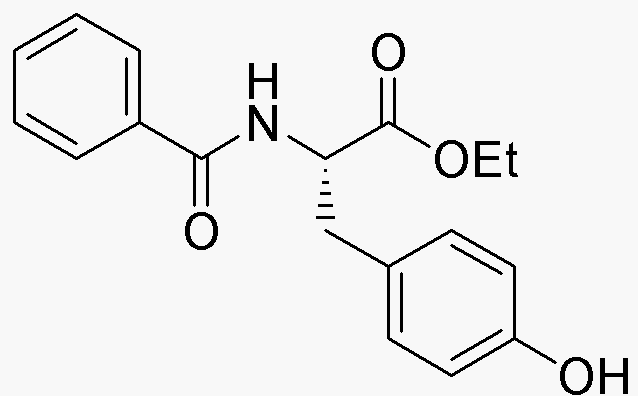Benzoyl-L-tyrosine ethyl ester is widely utilized in research focused on:
- Pharmaceutical Development: This compound serves as a precursor in the synthesis of various pharmaceuticals, particularly those targeting neurological disorders, due to its ability to cross the blood-brain barrier.
- Cosmetic Formulations: It is incorporated into skincare products for its antioxidant properties, helping to protect the skin from oxidative stress and improve overall skin health.
- Biochemical Research: Researchers use it as a model compound to study enzyme interactions and protein synthesis, aiding in the understanding of metabolic pathways.
- Food Industry: The compound is explored for its potential as a natural preservative, offering an alternative to synthetic additives while enhancing flavor profiles.
- Material Science: It is investigated for its role in developing biodegradable polymers, contributing to more sustainable materials in various applications.
General Information
Properties
Safety and Regulations
Applications
Benzoyl-L-tyrosine ethyl ester is widely utilized in research focused on:
- Pharmaceutical Development: This compound serves as a precursor in the synthesis of various pharmaceuticals, particularly those targeting neurological disorders, due to its ability to cross the blood-brain barrier.
- Cosmetic Formulations: It is incorporated into skincare products for its antioxidant properties, helping to protect the skin from oxidative stress and improve overall skin health.
- Biochemical Research: Researchers use it as a model compound to study enzyme interactions and protein synthesis, aiding in the understanding of metabolic pathways.
- Food Industry: The compound is explored for its potential as a natural preservative, offering an alternative to synthetic additives while enhancing flavor profiles.
- Material Science: It is investigated for its role in developing biodegradable polymers, contributing to more sustainable materials in various applications.
Documents
Safety Data Sheets (SDS)
The SDS provides comprehensive safety information on handling, storage, and disposal of the product.
Product Specification (PS)
The PS provides a comprehensive breakdown of the product’s properties, including chemical composition, physical state, purity, and storage requirements. It also details acceptable quality ranges and the product's intended applications.
Certificates of Analysis (COA)
Search for Certificates of Analysis (COA) by entering the products Lot Number. Lot and Batch Numbers can be found on a product’s label following the words ‘Lot’ or ‘Batch’.
Numéro de catalogue
Numéro de lot/série
Certificates Of Origin (COO)
This COO confirms the country where the product was manufactured, and also details the materials and components used in it and whether it is derived from natural, synthetic, or other specific sources. This certificate may be required for customs, trade, and regulatory compliance.
Numéro de catalogue
Numéro de lot/série
Safety Data Sheets (SDS)
The SDS provides comprehensive safety information on handling, storage, and disposal of the product.
DownloadProduct Specification (PS)
The PS provides a comprehensive breakdown of the product’s properties, including chemical composition, physical state, purity, and storage requirements. It also details acceptable quality ranges and the product's intended applications.
DownloadCertificates of Analysis (COA)
Search for Certificates of Analysis (COA) by entering the products Lot Number. Lot and Batch Numbers can be found on a product’s label following the words ‘Lot’ or ‘Batch’.
Numéro de catalogue
Numéro de lot/série
Certificates Of Origin (COO)
This COO confirms the country where the product was manufactured, and also details the materials and components used in it and whether it is derived from natural, synthetic, or other specific sources. This certificate may be required for customs, trade, and regulatory compliance.


